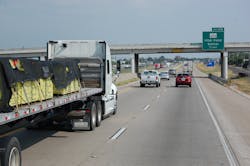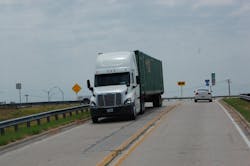That’s the view of Sandeep Kar (seen at right), group VP of mobility research for global consulting firm Frost & Sullivan.
In a webinar yesterday sponsored by GPS Insight and hosted by Fleet Owner, he argued that providing “cheap” telematics hardware and services via contracts to fleets in exchange for a “percentage of any revenues or savings” is a business model that should “gain a lot of traction” in the coming years.
[It’s also a “business model” OEMs have explored for other truck-related efficiencies such as fuel economy.]
“The business model in telematics is evolving,” Kar said. “In the past telematics hardware was expensive, but the services were not, largely because only location-based services were needed. Beyond 2007-2008, though, the model changed; hardware became cheap but services became more costly due to new back office and [vehicle] prognostic data needs.”
In the future, however, both telematics hardware and services will be cheap, allowing a much wider segment of the trucking industry to achieve efficiency gains. “The deal here, though, is that telematics providers will be getting into contracts with fleets to a get percentage of any savings,” Kar explained. “And fleets will be happy to do that; if they are saving $8,000 per year per truck and pay $1,000 to get that savings, it’s worth it.”
He added that this new business model is already being tested with “select fleets” within the industry and should “gain a lot of traction” in coming years.Several reasons will drive the adoption of this “shared revenue” approach to telematics, Kar argued.
“One reason is service and maintenance [as] prognostics data helps reduce vehicle downtime; that is the fastest growing proportion of telematics business today,” he said.
Kar also believes that “E-retailing” is changing the way trucks are used to deliver goods – driving the need for more data.
“Same day delivery becoming more important [and] that’s driving demand for city trucks in urban areas to make more ‘last mile’ deliveries,” he explained. “That’s also resulting in a ‘polarization’ of truck classes; with demand for heavy truck and light trucks growing in the future, while the medium duty market, one can argue, will shrink.”
Yet trucking telematics still remains a “highly reactive” service, providing data to both the driver and fleet manager and leaving them to make critical operating decisions with it.
“Is this the most efficient way to harness telematics data?” Kar asked. In his view, telematics is about connecting vehicles to world outside and vice versa, to help enhance efficiency.
Think about a truck that reaches its delivery point too early or too late. “Think of the time wasted, the excessive engine idling, and wasted fuel,” he said. “If you add traffic data, social media data, and crowd sourcing information via telematics to gain insight about obstacles ahead, instead of just the driver or fleet manager making mission-critical decisions, the machine itself can make those decisions.”
Yet if the truck begins to operate and guide itself, what happens to the driver? “That’s the next [telematics] piece – the plug-ins for social media and health monitoring services for drivers,” Kar noted. “In fact the area of highest R&D [research and development] growth at OEMs is on driver health and wellness in-cab monitoring.”
He added that this “proliferation of telematics” in trucking won’t just be driven by technology changes but by demographic changes as well, as younger drivers who want such “vehicle connectivity” enable a “market pull” for more telematics-based services.
“Real change will occur when that ‘market pull’ comes to telematics; and it’s about to arrive very fast,” Kar said.
About the Author
Sean Kilcarr
Editor in Chief
Sean Kilcarr is a former longtime FleetOwner senior editor who wrote for the publication from 2000 to 2018. He served as editor-in-chief from 2017 to 2018.


